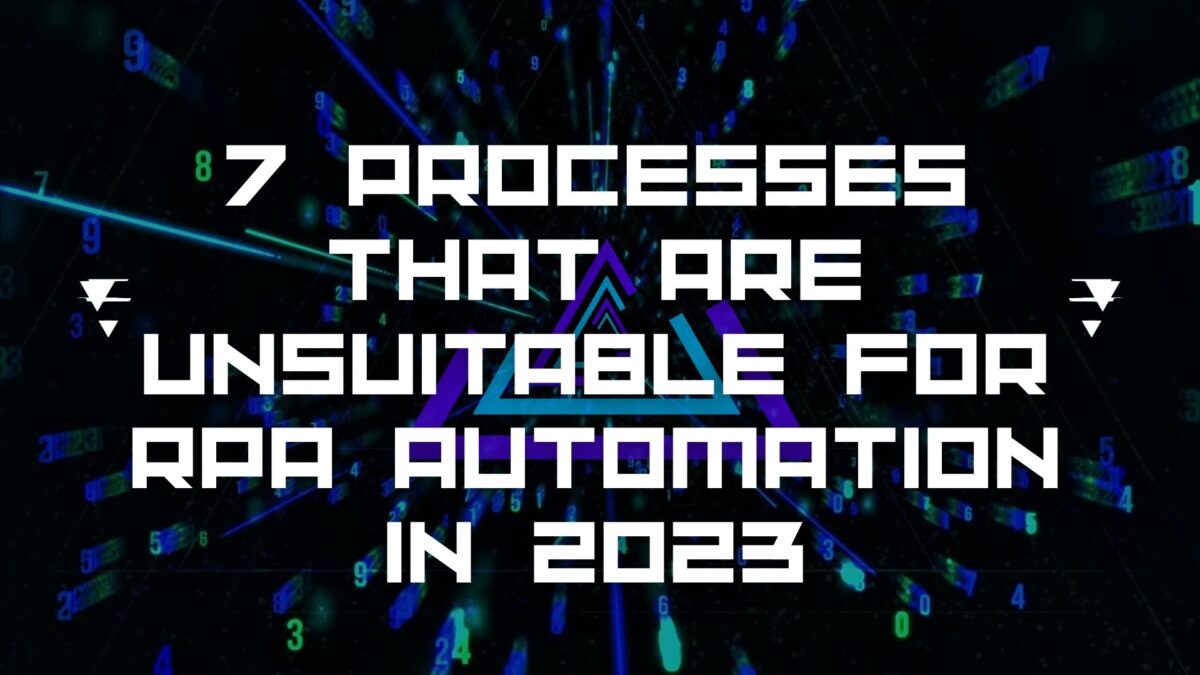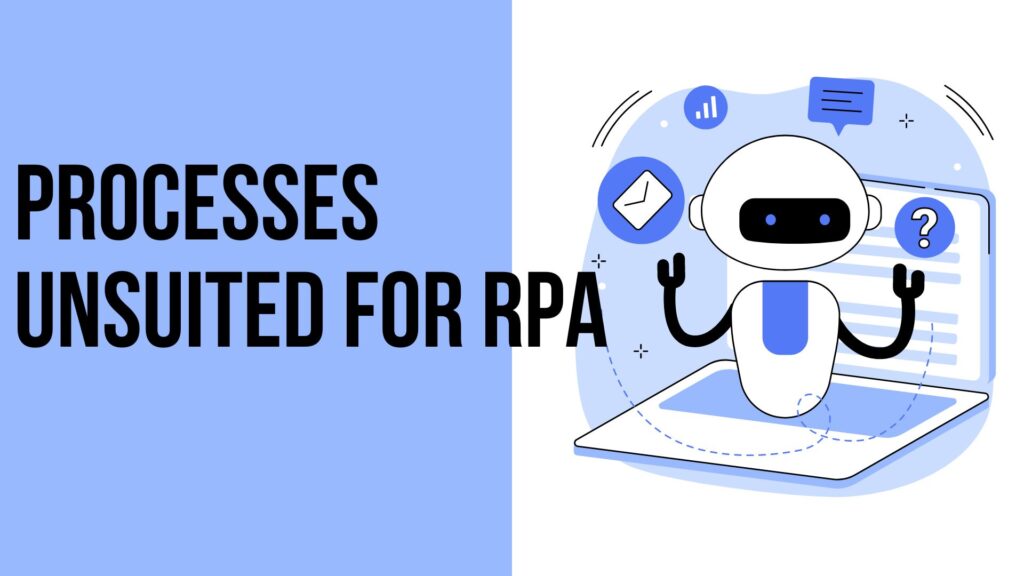This website uses cookies so that we can provide you with the best user experience possible. Cookie information is stored in your browser and performs functions such as recognising you when you return to our website and helping our team to understand which sections of the website you find most interesting and useful.
7 Processes That Are Unsuitable for RPA Automation in 2023

The business world in 2023 has seen an accelerating trend of Robotic Process Automation (RPA) adoption across diverse sectors. Industries such as banking, automotive, and others are harnessing the power of RPA to automate tedious, error-prone tasks, freeing up significant amounts of time, money, and human resources. However, despite its advantages, RPA isn’t a one-size-fits-all solution. Some processes pose unique challenges and complexities that render RPA less suitable. This comprehensive guide will delve into these processes, exploring why they are ill-suited for RPA, and suggesting how businesses might transform them for more efficient automation.
In 2023, despite the remarkable advancements in technology and the widespread adoption of Robotic Process Automation (RPA), there are still certain processes within the realm of mobile application development that remain unsuitable for automation. These processes require a high level of human intervention and expertise, making them challenging for RPA to replicate effectively.
A Closer Look at Processes Unsuited for RPA

In this section, we’ll delve deeper into seven types of processes which are not ideally suited for RPA and explore potential alternatives for these challenges.
1. Processes Requiring Constant Human Intervention
Certain processes, such as quality control, customer service, sales, and customer feedback analysis, are intrinsically human-centric and require constant human oversight. The keyword to underline here is “constant”. While RPA can indeed streamline these processes—by quickly retrieving pertinent customer data, for example—it cannot wholly replace the need for human involvement.
For instance, customer service often relies on human capacities for understanding, empathy, and judgement. An RPA-powered chatbot might handle initial customer inquiries, but providing nuanced responses and personalized service requires human intervention. This intertwining of RPA and human participation can be achieved through “human-in-the-loop” automation, which leverages the strengths of both elements.
2. Challenges with Unstructured Data
The second category of processes that are ill-suited for RPA involves those dealing with unstructured data. Surprisingly, an estimated 80-90% of business data exists in an unstructured format. Despite this, a Deloitte survey found only 18% of businesses utilize this type of data effectively.
If a business seeks to automate processes reliant on unstructured data—such as invoice automation, credit scoring, and resume screening—they must first organize this data, a task outside the capability of RPA. The solution lies in Intelligent Automation (IA), where RPA is augmented with Artificial Intelligence (AI) capabilities like Optical Character Recognition (OCR) and Natural Language Processing (NLP) to interpret and categorize unstructured data.
3. The Complexity Quagmire
The third category concerns processes that are inherently too complex for automation. Automating complex processes might lead to increased complexity and potential disruptions.
An illustrative example comes from a Southeast Asian bank that implemented roughly 2,000 RPA bots. Despite the seemingly straightforward task of copying data from one field to another, an unexpected change in the user interface caused operational disruptions. These complications arose because RPA companies function based on pre-written scripts and lack the Machine Learning (ML) capacity to adapt to changes.
To avoid this pitfall, businesses should employ process mining techniques before RPA implementation, gaining a thorough understanding of their current processes, their inefficiencies, and their complexity levels.
4. Profitability Concerns: ROI After Automation
RPA implementation comes with costs, which extend beyond the initial outlay for the software. These include maintenance, infrastructure, and potential future programming costs to customize the solution.
Businesses should ensure these expenses are justified by the economic and operational benefits of automation. Overestimating the Return on Investment (ROI) could lead to losses and derail future automation projects. As RPA bot prices continue to decrease, reassessing the potential ROI of RPA implementation is becoming increasingly vital.
5. Tackling Immature Processes
Processes that undergo frequent changes due to various factors—such as software infrastructure updates, employee turnover, or regulatory shifts—are deemed immature for automation. Automating such processes prematurely can lead to wasted resources and potential overhauls.
Companies can utilize free automation maturity assessment tests provided by RPA vendors to determine if a process is ready for automation. These assessments consider various factors, including established automation KPIs, presence of a dedicated automation oversight department, and past experiences with automation.
6. Considering Process Maturity
Automation can’t effectively be applied to processes that are immature or unstable. Factors contributing to process immaturity include changes in technical infrastructure, turnover of employees or department heads, changes in government regulations, and variations in the timing of financial close seasons.
Businesses should use RPA vendors’ free automation maturity assessment tests to gain an unbiased understanding of whether their processes are ready for automation. These assessments often cover several essential questions that can guide the decision-making process.
7. Training and Change Management
Before embarking on RPA implementation, businesses need to ensure their employees understand automation and its implications. This involves setting up a change management department to assist the RPA Center of Excellence (CoE) during the transition. An operating model should be established that clearly outlines each department’s role in the automation loop. It’s also essential to communicate the impact of automation on the company’s operations and future employment prospects.
Conclusion
While RPA offers significant benefits, it’s not a universal solution. Businesses need to assess their processes critically, identifying those that are ripe for automation and those that may require alternative approaches. By doing so, they can ensure the efficient and effective application of RPA and reap its full benefits.



